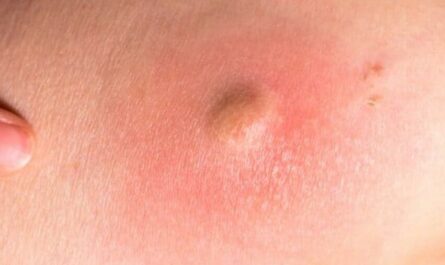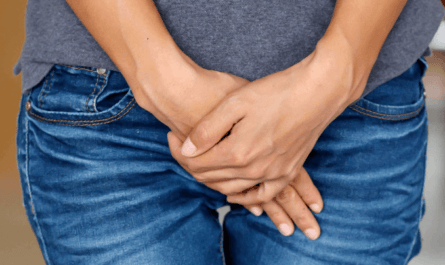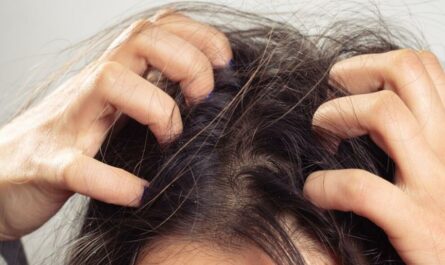Blocked or clogged ears can be a frustrating and uncomfortable experience. Whether it’s due to a sudden change in air pressure or an underlying health condition, the feeling of muffled hearing and pressure can be bothersome. Fortunately, there are several easy and natural methods you can try at home to help unclog your ears.
In this article, we will explore 16 simple and effective ways to unclog ears at home. These methods are safe, cost-effective, and can provide relief in many cases. However, it’s important to note that if you have severe pain, dizziness, or other concerning symptoms, it’s essential to consult a healthcare professional.
Know Your Ears First
The ear is a complex organ that can become clogged in many places. It usually consists of three parts.
- The outer ear is easily accessible from your face. The lodge allows the amplification of sounds entering the external auditory canal leading to the eardrum. Ear wax formed in your outer can easily clog the external ear canal.
- The middle ear is behind the eardrum and transmits the vibrations of the tympanic membrane to the inner ear by the ossicles (hammer, anvil, stirrup). A small duct, called the Eustachian tube, connects your middle ear to the nasopharynx to balance its pressure with the outside. Your Eustachian tube may also become blocked because of inflammation or secretions.
- The highly complex inner ear integrates sounds and codes into electrical impulses to transmit them to your brain via the auditory nerve. Your inner ear usually will not clog, but hearing problems can result from a malfunction of this organ.
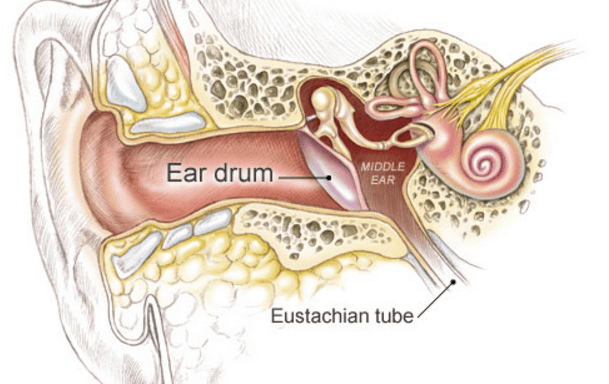
Common Causes of Blocked and Clogged Ears
- An airplane ear occurs when your ear cannot adjust to the drastic change in air pressure on an airplane. You can feel it when the plane takes off, lands, or is diving.
- An ear infection is also known as otitis media; it can lead to pain and clogged ears. You may feel your ear filled with fluid. Cold and stuffy sinuses can be the common causes of ear infections.
- Children are more prone to clogged ears because they have low immunity and are more likely to get colds and ear infections.
- Earwax buildup can block the ear canal and lead to clogged ears. Wearing hearing aids may worsen this condition.
- Swimming or bathing can cause water to enter the ear canal. This will make the water trapped in the ear and lead to an infection.
- Some small devices, such as cotton swabs, may be left in the ear canal. This will lead to clogged ears.
- Sometimes, allergies can also cause a clogged ear.
16 Easy Ways to Unclog Your Ears at Home
1. Chewing Gum
Chewing gum helps unclog ears by promoting the opening and closing of the Eustachian tube. It can stimulate the muscles around the Eustachian tube, allowing air to flow and equalize pressure.
- Purchase sugar-free chewing gum.
- Pop a piece of gum into your mouth and start chewing.
- Chew the gum slowly and deliberately for a few minutes.
- Repeat this process whenever you feel your ears are clogged or blocked.
2. Yawning and Swallowing
Yawning and swallowing help unclog ears by encouraging the opening and closing of the Eustachian tube. These actions activate the muscles surrounding the tube, facilitating air movement and equalizing pressure, relieving ear congestion.
- When you feel the need to yawn, allow yourself to do so naturally.
- If you don’t feel the urge to yawn, try to create the sensation by opening your mouth wide and taking a deep breath.
- You can also take a sip of water, swallow your saliva, or eat something.
- Repeat yawning or swallowing as needed to alleviate ear blockage.
3. Nasal Decongestants
Nasal decongestants help unclog ears by reducing swelling in the nasal passages. When the nasal passages are less congested, it allows for better airflow and relieves pressure, alleviating ear congestion.
- Purchase an over-the-counter nasal decongestant spray or drops.
- Follow the instructions provided on the packaging for proper dosage and usage.
- Tilt your head slightly and insert the nozzle of the spray or the dropper into your nostril.
- Administer the recommended number of sprays or drops into each nostril.
- Breathe gently through your nose to help the medication reach the affected areas.
4. Warm Compress
A warm compress helps unclog ears by increasing blood circulation and relaxing the muscles around the ear. The compress’s warmth promotes fluid drainage and relieves discomfort, making it an effective remedy for clogged ears.
- Take a clean cloth and soak it in warm water.
- Wring out the excess moisture from the cloth.
- Gently press the warm compress against the affected ear.
- Hold the compress against your ear for about 5 to 10 minutes.
- Repeat this process multiple times a day as needed to alleviate ear congestion.
5. Olive Oil
Olive oil helps unclog ears by softening and loosening excess earwax. It acts as a lubricant, making it easier for the earwax to move out of the ear canal naturally, thus relieving ear blockage.
- Warm some olive oil to body temperature.
- Use a dropper to put a few drops of warm olive oil into the affected ear.
- Tilt your head to the opposite side to allow the oil to reach the ear canal fully.
- Stay in that position for a few minutes to let the oil soften the earwax.
- Tilt your head back upright or use a tissue to wipe away any excess oil gently.
- Repeat this process twice a day for a few days until the earwax is cleared.
6. Hydrogen Peroxide
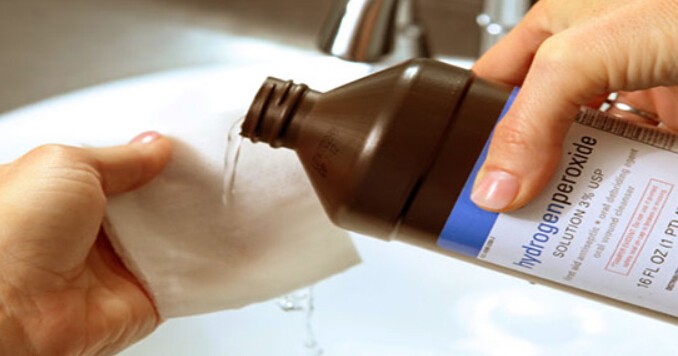
Hydrogen peroxide helps unclog ears by breaking the earwax and removing it. It acts as an effervescent agent to help soften and dislodge the blockage.
- Mix equal parts of hydrogen peroxide and water.
- Use a dropper to instill a few drops of the mixture into the blocked ear.
- Tilt your head to the opposite side to allow the solution to reach the ear canal fully.
- Stay in that position for a few minutes to let the hydrogen peroxide work on the earwax.
- Tilt your head back upright or use a tissue to gently wipe away any excess solution and earwax that may have come out.
- Repeat this process once daily for up to four days.
7. Saline Solution
Saline solution, also known as saltwater solution, helps unclog ears by flushing out nasal congestion. It helps moisturize the nasal passages, reduce inflammation, and promote proper drainage, alleviating pressure and clearing the blockage in the ears.
- Purchase a saline nasal spray from a pharmacy or prepare your own by dissolving half a teaspoon of salt in a cup of warm water.
- Fill a nasal spray bottle with the saline solution.
- Tilt your head slightly and insert the nozzle of the nasal spray into one nostril.
- Gently squeeze the bottle to release a mist of saline solution into your nostril.
- Allow the saline solution to flow through your nasal passages and out of the other nostril.
- Repeat the process with the other nostril.
8. Steam Inhalation
Steam inhalation helps unclog ears by easing sinus congestion. Inhaling steam moisturizes the nasal passages and helps loosen mucus. It can also help facilitate drainage and relieve the pressure in the ears.
- Boil water in a pot and remove it from the heat source.
- Place the pot on a stable surface.
- Lean over the pot, covering your head with a towel to create a steam tent.
- Breathe deeply and slowly through your nose, inhaling the steam.
- Continue inhaling the steam for about 5 to 10 minutes.
- Take breaks if needed, and avoid burning yourself with the hot steam.
9. Valsalva Maneuver
The Valsalva maneuver helps unclog ears by equalizing the pressure in the middle ear. By blowing air against a closed nose and mouth, you create pressure to help open the Eustachian tube and relieve ear congestion.
- Close your mouth and pinch your nose shut with your fingers.
- Take a deep breath and gently blow air through your nose while keeping your nostrils and mouth closed.
- You may feel a slight popping sensation or hear a soft click as the Eustachian tube opens up and the pressure equalizes.
- Repeat the Valsalva maneuver to relieve ear blockage, but be cautious not to blow too forcefully to avoid ear injury.
10. Over-the-Counter Ear Drops
Over-the-counter ear drops help unclog ears by softening and loosening earwax. These drops often contain ingredients such as hydrogen peroxide or mineral oil that help break down the wax and facilitate its removal.
- Purchase over-the-counter ear drops specifically formulated for earwax removal.
- Read and follow the instructions provided on the packaging carefully.
- Tilt your head to the side with the affected ear facing upwards.
- Gently pull the outer ear upward and backward to straighten the ear canal.
- Administer the recommended number of drops into the ear canal, as directed.
- Keep your head tilted for a few minutes to allow the drops to penetrate the earwax.
- Sit up or use a tissue to gently wipe away any excess drops and earwax that may have come out.
11. Apple Cider Vinegar

Apple cider vinegar helps unclog ears by balancing the pH levels in the ear. It possesses antibacterial and antifungal properties that can help combat infections and reduce inflammation, contributing to the relief of ear congestion.
- Mix equal parts of raw, unfiltered apple cider vinegar and water.
- Soak a cotton ball in the diluted apple cider vinegar solution.
- Gently squeeze out any excess liquid from the cotton ball.
- Place the damp cotton ball at the entrance of the affected ear, ensuring it does not block the ear canal completely.
- Leave the cotton ball in place for about 5 to 10 minutes.
- Remove the cotton ball and discard it.
- Repeat this process a few times a day until the ear congestion improves.
12. Tea Tree Oil
Tea tree oil helps unclog ears due to its antibacterial and antiseptic properties. When diluted and applied around the outer ear canal, it can help reduce inflammation and fight off infections.
- Dilute a few drops of tea tree oil with a carrier oil, such as olive or coconut oil.
- Mix the oils well to ensure proper dilution.
- Take a small amount of the diluted tea tree oil mixture on your fingertips.
- Gently apply the oil around the outer ear canal.
- Massage the area in circular motions to promote absorption.
- Repeat this process once a day or as needed to help alleviate ear congestion.
13. Garlic Oil
Garlic oil helps unclog ears due to its natural antimicrobial properties. It can help combat infections, reduce inflammation, and facilitate the clearance of ear blockages caused by earwax or fluid buildup.
- Crush a garlic clove and mix it with a carrier oil, such as olive or sesame.
- Heat the mixture slightly to infuse the oil with the beneficial properties of garlic.
- Strain out the garlic particles to obtain the garlic-infused oil.
- Allow the oil to cool to room temperature.
- Use a dropper to instill a few drops of garlic oil into the affected ear.
- Tilt your head to the opposite side to allow the oil to reach the ear canal fully.
- Stay in that position for a few minutes to let the garlic oil work on the ear blockage.
- Tilt your head back upright or use a tissue to gently wipe away any excess oil and earwax that may have come out.
- Repeat this process daily for a few days to help clear the ear congestion.
14. Stay Hydrated
Staying hydrated is essential for overall health, including ear health. Drinking adequate water helps maintain proper fluid balance in the body, including the nasal passages and Eustachian tubes. This can help thin the mucus and secretions, promoting better drainage and reducing the risk of ear blockage.
- Aim to drink at least eight glasses of water throughout the day.
- Carry a reusable water bottle to access water wherever you go.
- Stay mindful of your water intake, and make it a habit to drink water regularly.
- Maintain proper hydration to support optimal ear health and prevent ear congestion.
Frequently Asked Questions
1. Can I use cotton swabs to clean my ears?
No, it is not advisable to use cotton swabs or any objects to clean your ears. They can push the earwax further into the ear canal and potentially cause injury or damage to the delicate structures of the ear.
3. How long does it take for clogged ears to clear?
The time it takes for clogged ears to clear can vary depending on the underlying cause. In most cases, with the help of home remedies, ear congestion can improve within a few days. However, if the blockage persists or is accompanied by other symptoms, it’s best to consult a healthcare professional.
4. Can allergies cause clogged ears?
Yes, allergies can cause clogged ears. Allergic reactions can lead to swelling and congestion in the nasal passages and Eustachian tube, resulting in ear blockage and discomfort.
5. Are there any lifestyle changes that can prevent ear congestion?
Yes, certain lifestyle changes can help prevent ear congestion. These include maintaining proper hydration, avoiding exposure to environmental allergens, practicing good hygiene to prevent ear infections, and refraining from inserting objects into your ears.
6. Can earwax removal be painful?
Earwax removal should not be painful when done correctly and with the appropriate remedies. However, if you experience pain, discharge, or other concerning symptoms during removal, it’s important to seek professional medical advice.
When Should You See Your Doctor?
Many home remedies can help get rid of blocked ears. However, sometimes you need to see your doctor immediately.
- If you have tried many home remedies but can’t unclog your ears.
- If the earwax is so hard, you can’t remove it at home.
- Dizziness or hearing loss.
- Severe ear infection with ear pain or lots of discharge in the ear.
- The foreign matter inside the ear may damage the ear canal or periosteum.

